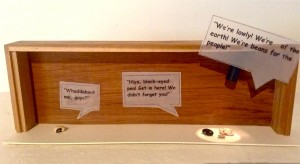

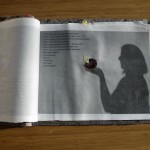
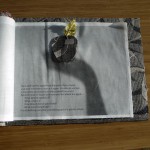
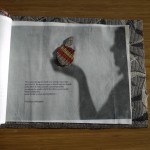
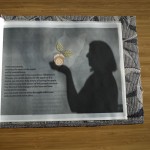
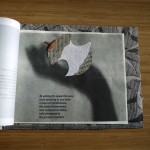

Construction no. 3
The inspiration for this construction comes from visualizing text in Savor: Mindful Eating, Mindful Life (Hanh & Cheung 2011). The authors are centered on the Buddhist practice of mindfulness as “a guiding light that already exists inside every one of us,” (7) “a way of living that has been practiced over twenty-six hundred years by millions of people to help them transform their suffering into peace and joy” (34). The authors suggest a simple exercise that is particularly suited to living in the Pacific Northwest. Their “Apple Meditation” exercise calls for mindfulness applied to eating an apple. According to the Washington State Department of Agriculture (WSDA), Washington accounts for 60% of US apple production (http://agr.wa.gov/AgInWa/). And serendipitously, the WSDA site offers a culinary agritourism Itinerary called .
So, lots of apples to taste, but the question raised by Hanh & Cheung is, “Are you Really Appreciating the Apple?” The text in construction no. 3 offers the steps to really appreciating the act of eating an apple. The apple is such a luscious fruit: color, crispness, sweetness and the promise of good health if one indulges every day is irresistible. Good thing, since we have so many wonderful apples available to us, and mostly at reasonable cost. When I was living in Japan for a time, apples were so expensive that it was never appropriate to munch a whole apple—no, in Japan, the practice is that an apple is cut into several pieces and the family group each takes one section as a dessert at the end of meal.
Last week I had the notion that a shadow image of myself would be a good starting point for the construction of images that might represent the steps of eating an apple with a sense of mindfulness and appreciation. Students in my critique group took this on: a light source in a darkened room projected my profile on a wall, the shadow was traced on paper accordingly—but the image was large and not crisp enough. Chantay, the eternal photographer that she is, offered to take a picture of my shadow and send it to me—digital ready. Perfect. The next weekend, a Portland friend stopped by after attending a workshop on fabric arts held in Port Townsend. She walked me through the process of making fabric rigid enough to go through a standard home printer. The idea emerged to use that technique to make pages for each step of savoring an apple. Making the pages took hours of PhotoShopping, experimental printing on paper, and playing with sizing. Then it was time to use the fabric sheets and six pages of shadow images and text were printed. The favored part of this construction was designing the tiny fabric apples secured to each page. My fabric scrap basket offered a profusion of possibilities—I started with leather and that remains my favorite—so smooth and rigid.

